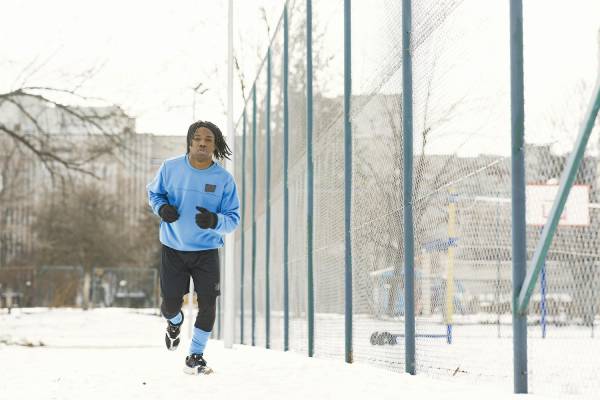Winter running is like stepping into a whole new world of challenges, and surprises. It can be beautiful, with quiet streets and snow-covered trails, but it can also be harsh. If you’ve ever stood by the door, debating whether to face the cold or crawl back under a blanket, you’re not alone. With the right tips and gear, winter running can become one of the best parts of your year. Let’s break it all down.

Start Warm Before You Head Outside
When it’s freezing outside, jumping straight into your run can feel awful. Your muscles are stiff, your lungs are shocked by the cold, and everything feels harder. That’s why warming up inside is so important. Don’t overthink it, no fancy moves are needed. Just do a few lunges, squats, or jumping jacks to get your blood flowing. Sometimes I throw in a couple of push-ups to feel like I’ve really earned my run. Two or three minutes is plenty to wake up your body and make that first step out the door a lot less painful.
The First Mile Feels Bad, But Push Through
Let me tell you straight up: the start of your run is probably going to suck. Your body’s cold, the air feels sharp, and your brain is screaming, “Why are we doing this?!” But here’s my secret: I promise myself I’ll give it five minutes. That’s it. Just five. If I’m still miserable after that, I can head back home guilt-free. Guess what? By the time the five-minute mark rolls around, I’m usually warmed up, finding my rhythm, and ready to keep going. The cold never feels quite as bad once you get moving, it’s like your body figures out, “Oh, we’re doing this? Okay, fine.”
Cold Air: It’ll Make You Cough, and That’s Normal
Breathing in icy air is… not the most pleasant thing. Your lungs work extra hard to warm up the air, which can make your breathing feel heavier at first. And then, when you’re back inside? Cue the dreaded “track hack”, that dry, scratchy cough that lingers for a few minutes. Don’t panic, it’s completely normal. Your body is just adjusting to the sudden temperature change.
If it’s really cold, a gaiter or scarf over your nose and mouth can make a huge difference. It helps warm the air before you breathe it in, so your lungs don’t have to do all the work. Plus, it keeps your face from freezing, which is a nice bonus.
Stay Upright on Ice and Snow
Running on icy sidewalks or snowy trails can feel like auditioning for an ice skating competition. But with a few tweaks to your stride, you can stay upright. Take smaller steps than usual and land directly under your body, this keeps your center of gravity stable and reduces slipping.
If you’re tackling a slippery patch, aim for the dull, white parts of the snow instead of the shiny, clear spots. The white parts usually have more grip, while the clear areas are often slick ice waiting to take you down. And don’t be afraid to slow down or even walk if you’re unsure, it’s better than risking a wipeout. Turning corners? Quick, tiny steps are your best friend.

Dress Like a Winter Running Pro
Choose the Right Layers
Winter gear isn’t just about staying warm, it’s about staying dry and comfortable too. Cotton? Big no. It soaks up sweat and leaves you freezing. Instead, stick to synthetic materials or wool, which keep you warm without getting soggy.
Start with a snug base layer that hugs your skin but isn’t too tight. It traps warmth and wicks away sweat. Over that, add a mid-layer for insulation and finish with a jacket or vest to block the wind. Make sure your outer layer fits well, not too tight to restrict movement but snug enough that it doesn’t flap in the wind like a kite.
Keep Your Fingers and Ears Warm
Your hands and ears are some of the first things to freeze, so protect them! Gloves or mittens are a must. For your head, a beanie or fleece-lined headband is non-negotiable. Trust me, frozen ears hurt. If it’s especially cold, double up with a hood or neck gaiter for extra coverage.
What About Socks and Shoes?
Wool socks are a winter runner’s best friend. They’re warm, they breathe, and they don’t get damp easily. That said, synthetic socks can work too, especially if you’re on a budget. As for shoes, your regular running pair should do just fine. The motion of running and the warmth from your socks will keep your feet comfortable without needing special winter shoes.
Be Seen in the Dark
Winter days are short, which means a lot of runs will happen in the dark. Don’t take chances, wear reflective gear or a vest with lights to make sure you’re visible. Safety first, always.
Enjoy the Winter Runs
There’s something special about running in winter. The world feels quieter, the air is crisp, and the sense of accomplishment is unbeatable. Sure, it takes a little extra effort, but that effort pays off. So warm up, layer up, and embrace the season, you’ve got this.




